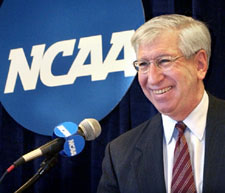The NCAA
The Voice and Conscience of College Sports
 When Myles Brand first became President of the NCAA, he faced a number of questions asking about the NCAA’s true role in intercollegiate athletics. People did not fully understand why the NCAA existed—let alone the importance of their mission. So, Brand sought to change perceptions of the Association and clearly establish the values that the NCAA represented.
When Myles Brand first became President of the NCAA, he faced a number of questions asking about the NCAA’s true role in intercollegiate athletics. People did not fully understand why the NCAA existed—let alone the importance of their mission. So, Brand sought to change perceptions of the Association and clearly establish the values that the NCAA represented.
Historically, the NCAA was established in 1906 by a small group of university presidents at the behest of President Theodore Roosevelt. At the time, student-athletes would often be severely injured during games, so their mission was to reform college sports regulations to make them safer for students. They succeeded, and the NCAA embodied a lasting obligation to set those standards and ensure contests were safe and fair.
In 2003, Brand aimed to demonstrate that the NCAA was still the voice and conscience of intercollegiate athletics, protecting the well-being and interests of student-athletes. He helped clearly articulate the importance of The Collegiate Model—which prioritized balance between academics and athletics—as well as guidelines for universities on how to maintain those values.
He also wanted to humanize the organization, ensuring that student-athletes always felt heard by the organization and its leaders. Under his guidance, the NCAA became less impersonal and rigid, more willing to listen to student-athlete concerns and consider individual cases independently.
During his tenure, Brand was occasionally criticized as the “czar of college sports,” saying that he either should or shouldn’t exert more control over the NCAA’s members. However, Brand repeatedly argued that the presidential leadership role of the NCAA was one of guidance and consensus. The NCAA president and his staff worked with college presidents, administrators, and athletic teams from over one thousand universities and colleges to implement change through oversight and leadership.
Together, the NCAA represents the collective voice of intercollegiate athletics, but Brand understood that only through cooperative consensus can they create the best experience for student-athletes across the country.
The NCAA
“BackTalk; In Athletics, Level Field Must Begin in Classroom,” The New York Times
May 9, 2004
“Education of College Athletes,” Brand responds to viewer messages about the NCAA’s proposal to improve the quality of college athlete education
May 29, 2004
“Where Credit Is Due,” Washington Post
September 28, 2004
“The Myths of College Sports: Debunking the Four Great Commonly Held Misperceptions About Intercollegiate Athletics,” NCAA State of the Association delivered at 2005 NCAA Convention
January 8, 2005
“Show Colleges the Money; University Sports in Need of Some Commercialism,” Chicago Tribune
April 6, 2005
“Putting the ‘Student’ Back into Student Athlete,” Black Issues in Higher Education, 22:4, pp. 28-30, by Kendra Hamilton
April 7, 2005
“NBA Plan Closes Door to College for Some,” Indianapolis Star
July 3, 2005
“NCAA Takes High Road with Ban of Offensive Mascots,” USA Today
August 11, 2005
“The Business of College Sports,” The Commonwealth, 99:16, pp. 15-18
August 15, 2005
“The Role and Value of Intercollegiate Athletics in Universities,” Journal of the Philosophy of Sport, 33:1, pp. 9-20
January 1, 2006
